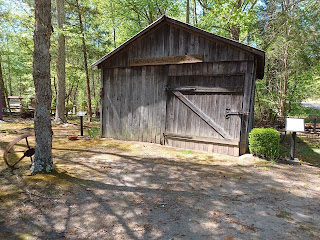I was gone from May 15-19 to explore two more counties within 500 kilometers of Morgantown.It's 264 miles from Morgantown to Xenia, the county seat of Greene County, and 243 miles from Greenup, the town that is the county seat of Greenup County, Kentucky to Morgantown. Xenia to Greenup is 125 miles. Xenia is just east of Dayton; Greenup is along the Ohio River downstream from Huntington, West Virginia and Ashland, Kentucky. I had some light rain in Xenia, but otherwise, the weather was good, cool in the morning and warmer in the afternoon.
I rode out of Morgantown north on I-79, took a left at Washington, Pennsylvania, bypassed Wheeling, West Virginia and had lunch in Zanesville, Ohio at the "Oriental Super Buffet," the first Chinese buffet I ever patronized. I drove on to Columbus, which I bypassed to the south, then traveled I-71, to U.S. 35 to Xenia. I stayed in Fairborn, a suburb of Dayton. The neighborhood was a park-like setting of office buildings, motels and restaurants. Beavercreek, another suburban town, was nearby, and I decided to check that out. I heard a few years ago, when I was in Springfield, Ohio, that Beavercreek Mall was where everyone in southwest Ohio went to shop. It's doing better than most malls, but I'm sure the pandemic hurt. I ate a slice of pizza and a tomato-cucumber salad for dinner at the mall.
Tuesday was my day to explore in Greene County. I spent most of the morning in Xenia, looking for historic places to photograph. I also noticed a lot of old American cars, which I like to view. I'll take my 2015 Honda Civic to drive. It's cleaner, smoother and gets better gas mileage than old American cars. I met Amy Cook, a lieutenant in Xenia's police force. She asked if I needed help. I probably looked distracted. I told her what I was doing. I said that downtown didn't look especially lively (I didn't say that it was mostly thrift shops and drug rehab centers), but the residential neighborhoods looked great. She said that people had been fixing up the downtown neighborhoods. I imagine there are gentrifiers who work in the office parks around Fairborn and Beavercreek who appreciate the older buildings in Xenia.
Greene County Courthouse, Xenia, completed 1902 Downtown Xenia Historic DistrictFormer Bank of Xenia, 1835
Downtown Xenia Historic District
Alexander Conner House, 1836, part of a row of 6
House in East Second Street Historic District
House in East Second Street Historic District
East Second Street Historic District
Hollencamp House, 1871 East Second Street
Shawnee Creek Rail Trail
Mural in Xenia
Waterstreet Historic District
Waterstreet Historic District
Millen-Schmidt House, N. King St., Xenia,late 19th century
Samuel N. Patterson House, N. King St., Xenia, 1860s
Shawnee Park
Xenia Carnegie Library. There is a new library that replaced this one.
I also visited Wilberforce University, a few miles east of Xenia, the first college for Black people in the country, now under the auspices of the African Methodist Episcopal (A.M.E.) church. They are in a new, modern-looking campus from the 1980s. The old Wilberforce is now Central State University.
On the campus at Wilberforce UniversityMural at Wilberforce University
Tower from Galloway Hall at Central State University, the old Wilberforce University. The rest of the building was destroyed by The Xenia Tornado in 1974
For the afternoon, I thought I would visit the northern part of Greene County, including Yellow Springs, a hipster hangout and the home of Antioch University. First, I went back to the original downtown Fairborn, where I had a decent meal at Lefty's Eats and Espresso on Main St. I walked around Main St., then drove up to Yellow Springs.
Fairborn Theater, 1948, still being restoredMercer Log House, 1799, Fairborn, now Greene County Historical Society
Bath Township Consolidated School, Fairborn, 1924, now senior housing
Lefty's Eats and Espresso, Fairborn
I thought I would hike in nearby John Bryan State Park, but, even thought the rain had stopped, the trails in the park were thick mush. I walked up and down the main street (Xenia Avenue, U.S. 68) in Yellow Springs. At Dark Star Books and Comics, I bought Maia Kobabe's memoir, Gender Queer, supposedly the most banned book in America, about a girl who is uncomfortable as she becomes a woman. Next door was a bakery, which had homemade chocolate chip cookies in the window, and also books for sale. Books and cookies (not necessarily in that order) are two of my biggest addictions. I bought a used copy of Carl Hiaasen's Basket Case, as well as a yummy cookie.
John Bryan State Park
Xenia Avenue, Yellow Springs Historic District
Pride display, Yellow Springs
I never made it to Antioch University, as it was getting to be nap time. There were police cars at the Interstate exit. I didn't know why. I napped at the motel, then walked to dinner at Bob Evans, just down the street from the motel. The parking lot was jammed, but the restaurant was nearly empty. I asked the hostess if something was going on. She said they had asked people not to park in their lot, but Kevin Hart was appearing at Nutter Center at Wright State University, across the street from the restaurant. I just said "Oh," then looked up Kevin Hart on my phone. He's a famous comedian who was in trouble over some homophobic remarks he once made. I don't know modern comedians after Ellen DeGeneres, and I'm mostly comfortable with the first cast of Saturday Night Live: Chevy Case, John Belushi, Jane Curtin, Gilda Radner, that crowd. I'm a "codger."
Back at the room, I planned for my trip to Greenup County, about two hours away.
































































